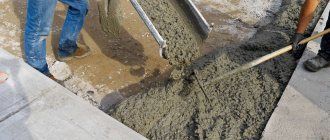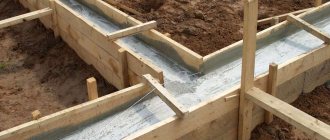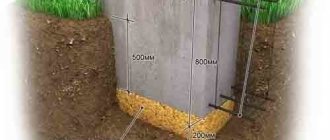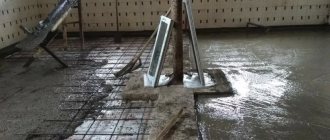The question of at what temperature concrete can be poured is very important, since not only the technical and operational characteristics of the hardened monolith, but also the general probability of undergoing the hardening process largely depend on it. Concrete poured at the wrong temperature or frozen during hardening can become covered with cracks, demonstrate lower strength and durability in comparison with standard values, and cause deformation or complete destruction of the structure or building.
In order for concrete to gain its design strength and guarantee a long service life, it is very important to observe the temperature regime both at the time of pouring and throughout the entire curing time (28 days). The optimal air temperature is around +20 degrees. But it is not always possible to meet this condition on a construction site.
Quite often it becomes necessary to pour concrete at sub-zero temperatures or during the work the weather suddenly deteriorates. In such cases, different methods of heating the concrete are used, anti-frost additives are introduced into the mixture, the structure is insulated directly on the site, etc. Before using any of this heating methods, you must carefully study its features and implementation conditions.
The process of strengthening concrete structures
To determine to what temperature concrete can be poured, it is necessary to first, at least superficially, consider the features of the process of gaining strength by a monolith. The reaction begins to occur between cement/water at the moment of mixing. In the first hours, the concrete is still fluid and can be worked with, but after several hours it begins to harden, becoming first thicker and then completely hard.
The process of interaction between water and cement is called hydration. Hydration takes place in two stages: first the mixture sets, then hardens. Aluminates are involved in setting, and needle-shaped crystals appear, interconnected. After 6-10 hours, these crystals become a kind of frame, skeleton. The concrete begins to harden.
The entire setting process can take from 20 minutes to 20 hours, which directly depends on the ambient temperature. The process takes the longest in the cold season - when it’s about 0 outside, the concrete begins to set in 6-10 hours, the stage lasts 15-20 hours.
During the hardening process, clinker minerals react with the water in solution, and a silicate structure is gradually formed. The reaction provokes the appearance of small crystals, which combine into a unique finely porous structure. This is concrete, which within 28 days already gains brand strength and durability without changing its shape and structure.
The optimal temperature value for the hardening stage is also +20 degrees, humidity – up to 100%.
Deviations from the parameters significantly affect the strength: complete maturation of the monolith lasts several years (but the set of design strength must be completed 28 days after pouring), the hardening rate changes over time.
The influence of negative temperature on concrete hardening
As mentioned above, the rate of hydration is very dependent on the ambient temperature. Thus, when decreasing from +20 to +5 degrees, hardening occurs on average 5 times slower. Further, the lower the temperature, the slower the reaction. When the temperature reaches sub-zero, hydration stops altogether (the water simply freezes).
At the moment of freezing, water tends to expand, which causes an increase in pressure inside the concrete solution and destruction of already formed crystal bonds. The structure of concrete is destroyed and cannot be restored in the future. In addition, ice that appears in the mixture can envelop large fillers, destroying adhesion to cement. All this significantly worsens the solidity of the structure and reduces strength.
When the water thaws, hardening continues, but the structure of the concrete is already deformed. Delaminations, deformations, cracks may appear, and separation of large fillers and reinforcement from the monolith may occur. The earlier the freshly poured concrete freezes, the lower the strength indicator will be.
Under what conditions should concrete not be poured?
- When the ambient temperature is at +5 C and below, and no measures to warm up or increase the frost resistance of concrete are planned.
- In the off-season - when the temperature is unstable, there are strong jumps in both the marks on the thermometer and the humidity.
- If the thermometer shows a temperature of +25 degrees or higher, and air humidity is below 50%. At such times, it is better to use special cements or not carry out work, since the hydration process will occur very quickly: the water will evaporate, and the concrete will not have time to gain strength, as a result of which cracks, deformations, peelings, etc. often appear.
- Pouring concrete at sub-zero temperatures without warming up for at least 3 days up to +10-30 degrees.
- When concrete with special additives has already been prepared, and a thaw suddenly sets in outside the window or the air humidity becomes above 60%, it starts to rain, etc.
- In case of inability to determine the optimal heating mode, set up devices, control concrete in cold weather. After all, both frost and overheating are equally dangerous for concrete.
At what optimal temperature can concrete be poured?
- From +5 to +20 degrees are normal conditions for pouring concrete prepared according to a standard recipe.
- From zero to +5 degrees - exclusively with the use of special additives.
- From 0 to -20 degrees - with special additives and heating.
- Ideal conditions are concrete temperature +30 and air temperature +20, humidity up to 100%.
Concreting in winter
It may be necessary to use concrete in cold weather in a variety of cases - when it is unprofitable to stop construction for an entire season, in case of emergency work, etc. Taking into account the detrimental effect of sub-zero temperatures on the material and its technical characteristics, concrete must be heated. When the temperature inside the solution is higher than the temperature outside, deformations may occur.
The concrete is heated until a critical strength indicator is reached. If such data is not in the design documentation, then the value is taken as 70% of the design strength. When there are requirements with waterproof/frost resistance values, then the critical strength is 85% of the design.
The main methods of heating concrete for pouring at minus temperatures:
- Warming up the components themselves to prepare the mixture.
- Using the thermos effect.
- Implementation of electric heating.
- Application of steam heating.
Thus, there is no question at all at what minimum temperature concrete can be poured. The task is to optimally prepare the mixture and the object in accordance with the working conditions to preserve the technical properties of the material and the basic requirements for strength, reliability, and durability.
The simplest and cheapest option is to heat up all the components used to prepare concrete. They are heated so that at the time of pouring the concrete has a minimum temperature of +35-40 degrees.
All materials except cement are heated: crushed stone/sand up to +60, water up to +90, cement is simply left in a warm room for a while (so that it is at room temperature). Then mix all the components and fill.
Thermos method
This option is relevant in the case of pouring massive structures. Additional heating is not provided, but the mixture being laid must exhibit a temperature of at least +10 degrees (preferably more). This method consists in allowing the poured mixture to acquire critical strength during the cooling process.
The principle of this method is that the concrete reacts and begins the hardening process, which is exothermic (that is, accompanied by the release of heat). Thus, the concrete will self-heat. If heat loss is excluded, concrete can warm up to +70 and above.
The formwork is reliably protected with heat-insulating materials, eliminating heat loss from concrete that is in the process of hardening. Water does not freeze, the concrete monolith gradually gains strength without destroying the internal structure. This option is used for pouring foundations in winter; it is considered the simplest and most economical, since it does not require the use of any equipment.
Electric heating of concrete mixture
When thinking about the temperatures at which concrete can be poured, many consider electric heating as a way out of the situation. Warming up can be carried out using several methods: using electrodes, the induction method and various electric heating devices.
Heating by electrodes is carried out as follows:
- Electrodes are introduced into the freshly poured mixture.
- Then current is applied to the electrodes.
- As current passes through the electrodes, they heat up and transfer heat to the concrete.
The current must be alternating, since a constant one will cause the electrolysis process, which is accompanied by the release of gas. The gas shields the surface of all electrodes, the current resistance increases significantly, as a result of which heating is noticeably reduced. If reinforcement is laid in concrete, it can be used as an electrode.
For this method to work, it is necessary to ensure that the concrete is heated evenly and to a maximum of +60 degrees. Electricity consumption in such cases usually does not exceed 80-100 kWh per cubic meter of concrete solution.
Induction heating is used quite rarely, since its implementation involves a number of difficulties. This type of heating of the concrete mixture works on the principle of non-contact heating of electrically conductive materials with high-frequency currents. So, an insulated wire is wound around steel reinforcement, and current is passed through it. Thus, induction appears, the reinforcement heats up and warms the concrete. Electricity consumption is usually 120-150 kWh per cubic meter of concrete.
The use of electric heating devices involves the use of a variety of means to reduce the negative impact of frost on the process of hydration of the mixture. These could be heating mats, for example, which are laid out on concrete and then connected to the network. You can make something like a tent over the flooded monolith, install a heat gun inside and heat it.
Here it is important to ensure that moisture is retained in the concrete so that it does not dry out during the heating process, which also negatively affects the quality and strength, just like cold (when freezing). Electricity consumption (provided that the ambient temperature is about -20 degrees) is 100-120 kWh per cubic meter.
Steam heating of concrete in winter
When the ambient temperature is at zero or below, it makes sense to think about heating the concrete with steam. This method is especially effective for thin-walled structures. Channels are made in the formwork on the inside and steam is released through them. Sometimes double formwork is made, and steam is passed between the two walls. You can install pipes inside concrete and then release steam through them.
Using this method, you can heat concrete to +50-80 degrees. Such a high temperature and optimal humidity accelerate the hardening process several times. Thus, in 2 days with steam heating, concrete gains strength similar to hardening within a week under normal conditions.
How long does it take to warm up concrete?
The concrete is heated until it reaches critical strength (30-50% of the design strength). This usually happens on the 4th-6th day.
The strength of concrete is determined by the actual temperature conditions using graphs.
To more accurately determine the timing, laboratory tests are used, for which sample castings are made and allowed to gain strength under the same conditions as the main structure.
The use of anti-frost additives during winter concrete work guarantees the production of high-quality concrete structures even in conditions of negative temperatures. Combining the use of antifreeze additives with the thermos method or heating the concrete not only guarantees strength gain, but also reduces the duration of heat treatment, which means it saves energy and increases the turnover of expensive equipment and formwork. Proper use of warming measures and anti-frost additives in accordance with the technological map allows us to obtain high-quality winter concrete.
Using additives in cold weather
Today, the use of antifreeze additives and special chemical accelerators for concrete hardening is very common. Most often, these additives are sodium nitrite, chloride salts, calcium carbonate and others. Additives significantly lower the freezing point of water and activate the hydration of cement (thus increasing the pour point of concrete).
By adding additives to the mixture, the need for heating can be avoided. Some additives can increase the resistance of concrete to frost so much that the question of whether concrete can be poured at subzero temperatures is not worth it at all: hydration takes place even at an ambient temperature of -20 degrees.
But, despite all the advantages, additives also have some disadvantages.
What you need to remember when introducing additives into concrete:
- They have a detrimental effect on the reinforcement - the corrosion process can begin, so it is important to introduce additives only into unreinforced concrete.
- Additives allow the concrete to gain strength equal to a maximum of 30% of the design value, and then when the mixture thaws (at positive temperatures), the process of strength gain continues. In this regard, according to SNiP, additives cannot be introduced into concrete operating under dynamic loads (hammers, vibrating machines, etc.).
Main types of antifreeze additives:
- Sulfates actively release heat, accompanying the hydration process. They bind strongly to poorly soluble compounds; they cannot be used to lower the freezing point of the mixture.
- Antifreeze - reduces the crystallization temperature of the liquid, increases the rate of setting of the solution, does not affect the rate of formation of structures.
- Accelerators - increase the solubility of silicate components of cement, they react with hydration products, create basic and double salts, which lower the freezing point of the liquid in the solution.
The most common antifreeze additives:
- Calcium carbonate (potash) is a crystalline substance, an antifreeze component that accelerates setting and hardening. Reduces the strength of a concrete monolith by 20-30%, so it is usually combined with sulfide-yeast mash (sodium tetraborate) at a concentration of a maximum of 30%.
- Sodium tetraborate (sulfate-yeast mash) is a mixture of calcium, sodium, ammonium salts or lignosulfonic acids. The additive is used as an admixture to potash and prevents concrete from losing strength.
- Sodium nitrite is a crystalline powder, a toxic, fire-hazardous substance, used in the construction of multi-story buildings, it dissolves easily, does not destroy reinforcement, and increases the hardening rate by 1.5 times.
- Calcium or sodium formate - used with plasticizers in a volume of no more than 2-6% by weight of the solution. Added during the kneading process.
- Ammonia water is a solution of ammonia in a concentration of 10-12%, does not provoke metal corrosion, and does not cause efflorescence.
Conclusion
When carrying out reinforced concrete work in frosty weather, it is necessary to use heating. Without it, the resulting structure will be less strong and durable (also find out how a transformer works for heating concrete).
The most common heating methods include the use of heating wires, infrared emitters, electromagnetic induction, and thermal insulation. The video in this article will tell you more about how concrete is heated in winter.
Concreting in dry, hot climates
Concrete does not like not only frost, but also heat. When the air temperature rises to +35 and above, and the humidity is at 50%, water evaporates too quickly, which provokes a violation of the water-cement balance. Hydration slows down or stops altogether, and therefore the concrete must be protected from too rapid loss of moisture.
To lower the temperature of the mixture, use chilled (or diluted with ice) water. This prevents rapid evaporation of water during the laying of the mixture. After a certain time, the mixture heats up, so it is important to ensure the tightness of the formwork (so that water does not evaporate through the cracks). Formwork can also absorb moisture, and therefore, to limit the adhesion of concrete and structural material, it is treated with special compounds before pouring.
Hardening concrete is protected from direct ultraviolet rays - the surface is covered with tarpaulin (burlap), and the surface is wetted every 3-4 hours. Moisturizing may be necessary during the entire 28 days of the monolith gaining strength.
The following method is often used to protect concrete from heat: an airtight cap made of PVC film with a thickness of at least 0.2 millimeters is created above the surface.
Concrete prepared according to the recipe is able to set, harden and acquire all design characteristics at an ambient temperature of +20 degrees and a humidity of about 100%. If work is carried out in frost or heat, it is necessary to take care of heating or cooling measures that will guarantee the strength and durability of the finished structure.
Timing
When calculating the heating of concrete, it is necessary to take into account factors such as the type of structure, the total heating area, the volume of concrete and electrical power.
During heating work with concrete, it is worth developing a technological map. It will include all the values of laboratory observations, as well as the heating time and hardening time of the material.
Calculation of concrete heating begins with the selection of a scheme. For example, the four-stage method is most often chosen. The first stage involves curing the material. After this, the temperature indicators are increased to a specific value, heating and cooling are carried out; the duration of holding before the start of the event is approximately 1-3 hours at a low temperature. After this, you can proceed to the calculation of heating, which is directly dependent on the speed and final temperature.
Throughout the entire process, it is worth monitoring the temperature, noting all results when it rises after 30-60 minutes, and when cooling, monitoring is carried out once per shift. If the mode is violated, it is necessary to maintain all parameters by turning off the current and increasing the voltage. In this case, the actual indicators and those obtained during the calculation may not coincide. After this, a graph of the dependence of time on strength is constructed, where the required value of time and heating temperature is indicated, and then the required value of strength is found.
The process of heating concrete is a very important event, without which the concrete structure will simply cease to gain strength in cold weather, resulting in a decrease in grade and further destruction. It is not difficult to carry out all these activities; you just need to determine which of the presented ones suits you best.











